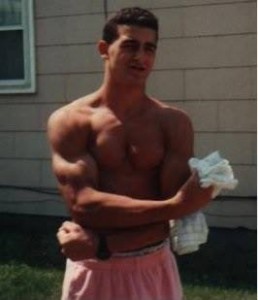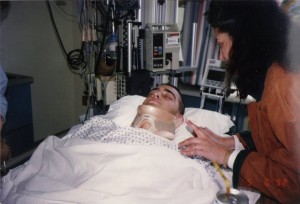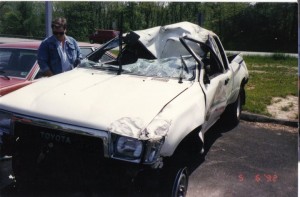Hello there. My name is Joseph Barrett. I, like many of my readers, have a disability. I was injured in an auto accident in 1992 and damaged my spinal cord. I have been in a chair ever since. More about me later.

Let me tell you a story about the birds and the bees. Well, actually, it’s really just about the birds. For as long as I can remember, I was never all that keen on owning a pet bird. This disenchantment probably began when my mom got coerced into adopting someone else’s lovely feathered friend.
I’m just going to put this out there–that bird needed to die … a lot! Seriously, how could such a small animal consistently make such outrageously loud sounds while I was trying to oversleep?
Every now and then this bird would manage to escape its cage and fly all around the house. Inevitably, it would make its way over to the curtains by the sliding-glass door—seemingly waiting for the opportunity to fly off and be free forevermore.
However, this bird never wanted to fly off and soar to great heights. In fact, it would always return to its cage—the same 2×2 confined space that inhibited its ability to fly great distances and explore exotic habitats while being completely independent in finding food and a mating partner(s).
All of this wondrous ability was lost because people insist on domesticating birds. If a bird is hatched in captivity or caged after being captured, the tendency is probably for it to explore and fly off whenever possible. After all, it is their nature to be free. Over time, a caged bird begins to exhibit a common pattern of resistance, which is subsequently followed by acceptance. Some folks refer to this phenomenon as ‘learned helplessness.’ The bird has learned to love the cage.
You knew where I was going with this, didn’t you? Learned helplessness and acceptance of a life that is unfulfilled is found all too often in our society: individuals who choose to stay in bad relationships; those who are unhappy in their job; and folks who give-up because of a disability are just a few examples. To be fair, starting all over again can be tough, and that is why people cling to an otherwise miserable situation.
Consider the life of an individual with a disability. Having a disability and being limited in some area of life is one thing, but being able to do more and not trying is a tragedy. For that person who is paralyzed, you start to wonder whether she or he is more immobilized by their disability or their fear. I’m not trying to sound like Tony Robbins, but it takes courage to step outside of your comfort zone. Real courage is found when one acts in the face of uncertainty. It is found when one lets go of their glory days and old identity. Of course, this doesn’t mean that you must forget good times and old memories hanging with your pals, but you get the point—people must move on. No one cares who you were. Besides, do you really believe that you were the best that you could be in your teens or twenties? It’s kind of pathetic to feel this way, but it’s something that plagued me for a long time.

I was a very muscular and athletic kid—I played sports and was at the gym all the time. Though I was always in gifted and talented classes, I chose to focus on ephemeral traits, such as athleticism. The enduring qualities of a healthy intellect and an eagerness to learn were neglected. After becoming disabled, those are the traits that I needed to focus on more than ever.
In the rehabilitation field, people love to conceptualize adjusting to a disability as a stage process. Below is a basic overview of these stages, which will include a bit of detail about my experience. Keep in mind that everyone’s adjustment is unique and specific to the person.
Stages of Adjustment
Shock: in the shock phase, the “individual’s thinking is often disorganized, and he or she may be feeling overwhelmed and confused” (Smart, 2009, p. 392). I was a senior in high school when I was injured. I had Navy and Marine recruiters trying to undermine each other’s recruiting efforts so that I would sign with them. I chose the Navy.

In the blink of an eye, all that changed. I was flown to the University of Maryland Shock Trauma on May 1st, 1992 and discharged to A.I. DuPont 11 days later to begin a 6 month long rehabilitation regimen. I was broken and overwhelmed.

Defensive Retreat: in this stage, the individual often employs temporary adaptive strategies, such as denial. For example, he or she may deny: the “presence, implications, and permanence of the disability” (p. 393). Denial can be functional in the initial stages of one’s disability as it prevents “emotional flooding” (p. 394). However, over the long term, denial can be counterproductive and inhibit adaptive change and acceptance (p. 396). Denial quickly became my best friend. I was going to beat the odds and walk again.
All of these terms and routines that doctors, nurses, and therapists were lobbing at me were irrelevant. I regained the use of my arms—the legs were next!
Depression or Mourning: in this stage, the individual “often withdraws from others and has trouble sleeping, eating, and concentrating” as he or she “struggles with questions of an uncertain future and an uncertain identity” (pp. 396-397). Late into my rehabilitation, the gains slowed. It was becoming obvious that the legs weren’t coming back. I slipped into a deep depression and refused to eat. I lost 30-40 pounds and wanted to sleep all day.
Personal Questioning: common in this stage is questioning about why the disability was allowed to happen and what could have been done to avoid it (pp. 400-401). “Why me?” I must have asked that question a million times. This was supposed to happen to other people, not me. I was raised Catholic and had Jesus on speed-dial: “Hey God, get me out of this chair and I’ll do a whole bunch of good stuff.” It didn’t happen.
Adaptation, Change, and Integration: at this point in the adjustment process, the individual “understands and accepts the reality and implications of the disability, establishes new values and goals …, and explores and uses his or her strengths and abilities” (pp. 402-403). As much as I would like to say that these events happened in rapid succession, they didn’t. In the words of Axl Rose, “Welcome to the Jungle.” This is the dark side of the disability experience—long periods of isolation. In my situation, we’re talking about a good 5 to 6 years. As in the opening vignette, I had become like a caged bird. I didn’t date. I didn’t talk to many people. I simply went away. I read lots and lots of books. I finally came up with an answer to the question “Why me?” Here it is: “Why not me?”
When people would ask me what I did for a living, I got so embarrassed—I just didn’t have a good answer. I saw people in chairs driving cars and living their lives. That’s what I wanted, but I couldn’t seem to put the pieces together. I had problems with my body image and became so self-conscious that I couldn’t even look people in the eye.
One day I just had enough. The fighting spirit started to come back. I remembered seeing a guy at Maryland Rehabilitation Center (now the Workforce & Technology Center) with a similar injury drive a van. That experience was so powerful in giving me the confidence to rebuild my life. I began to let go of the victim mentality and started to put together a plan of action—I came out swinging.
I contacted the Division of Rehabilitation Services for a driving evaluation and eventually started to drive again. I enrolled in school and graduated Summa Cum Laude with a BS in Psychology. In addition to working at The IMAGE Center, I am now an intern at the Division of Rehabilitation Services with 1 class left to finish my M.A. in Rehabilitation Counseling.
So, what about you? Is any of this applicable to your situation? Is there any fight left in you? If you’re struggling with your disability and want more from life, I would welcome the opportunity to work with you. There is no reason to waste time in isolation feeling helpless. Contact The IMAGE Center—let’s kick open that cage and reclaim your life.
References
Roth, E. (Director). (1995). Forrest Gump : Paramount Pictures.
Smart, J. (2009). Disability, society, and the individual, 2nd Edition. Austin: Pro-Ed.
